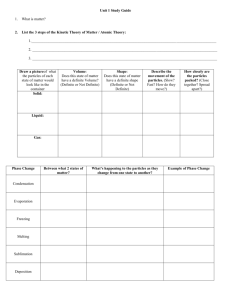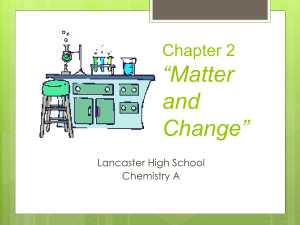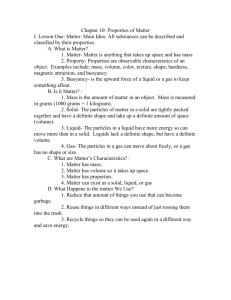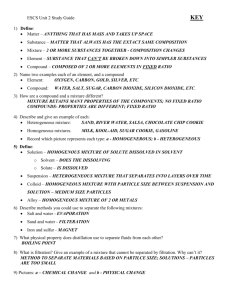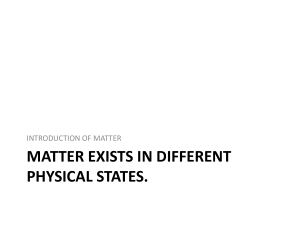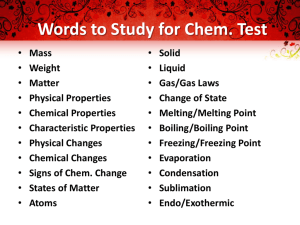Unit 2 Notes
advertisement
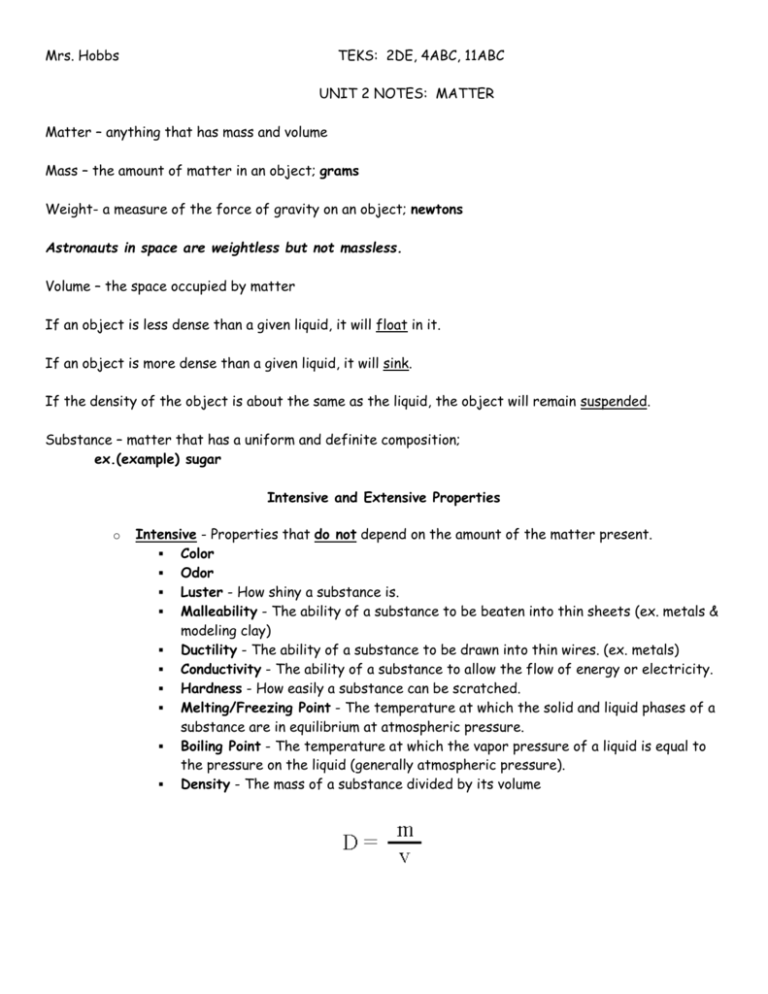
Mrs. Hobbs TEKS: 2DE, 4ABC, 11ABC UNIT 2 NOTES: MATTER Matter – anything that has mass and volume Mass – the amount of matter in an object; grams Weight- a measure of the force of gravity on an object; newtons Astronauts in space are weightless but not massless. Volume – the space occupied by matter If an object is less dense than a given liquid, it will float in it. If an object is more dense than a given liquid, it will sink. If the density of the object is about the same as the liquid, the object will remain suspended. Substance – matter that has a uniform and definite composition; ex.(example) sugar Intensive and Extensive Properties o Intensive - Properties that do not depend on the amount of the matter present. Color Odor Luster - How shiny a substance is. Malleability - The ability of a substance to be beaten into thin sheets (ex. metals & modeling clay) Ductility - The ability of a substance to be drawn into thin wires. (ex. metals) Conductivity - The ability of a substance to allow the flow of energy or electricity. Hardness - How easily a substance can be scratched. Melting/Freezing Point - The temperature at which the solid and liquid phases of a substance are in equilibrium at atmospheric pressure. Boiling Point - The temperature at which the vapor pressure of a liquid is equal to the pressure on the liquid (generally atmospheric pressure). Density - The mass of a substance divided by its volume o Extensive - Properties that do depend on the amount of matter present. Mass - A measurement of the amount of matter in a object (grams). Weight - A measurement of the gravitational force of attraction of the earth acting on an object. Volume - A measurement of the amount of space a substance occupies. Length Extensive properties – depend on the amount of substance present; ex. mass, volume, length Intensive properties – do not depend on the amount of substance present; ex. density, color, melting point etc. 4 States of Matter: 1. Solid – matter with a definite shape and a definite volume; ex. wood, brick, desk, rock 2. Liquid – matter with a definite volume but no definite shape; takes the shape of its container, flows, almost incompressible; ex. water, milk, mercury 3. Gas – matter with no definite volume and no definite shape; takes the shape and volume of its container, easily compressed; ex. helium, air, oxygen, nitrogen 4. Plasma – matter that has lost its electrons due to extremely high temperatures (greater than 10,000 oC); ex. lightning, stars, neon signs, mercury and sodium vapor street lights Not a state of matter solid at room temperature; ex. gasoline, ammonia Vapor – the gaseous state of a substance that is generally a liquid or Phase Change or Change of State: a change from one state (solid, liquid or gas) to another without a change in chemical composition Changes of State: 1. 2. 3. 4. 5. 6. melting – solid to liquid; ex. ice cube at room temp. freezing – liquid to solid; ex. making ice cubes evaporation – liquid to gas; ex. puddle drying up, boiling water condensation – gas to liquid; ex. sweating glass, dew, rain, fogged up mirror sublimation – solid to gas; ex. dry ice, iodine sublimation – gas to solid; ex. hailstones, snow Solids: 1. 2. 3. 4. 5. Liquids: 1. 2. 3. 4. 5. Gases: 1. 2. 3. 4. 5. definite shape & volume Very dense, particles highly packed Particles organized in fixed positions Particles held by strong attractive forces Not compressible No definite shape but definite volume Relatively dense Particles held by weak attractive forces Can flow Not compressible No definite shape & No definite volume No attractive forces between particles Lots of empty space between particles Can be Compressed Not very dense Kinetic Theory – as the temperature of particles increases, the motion of particles increases and vice versa Effect of air pressure on boiling point (p. 278): An increase in air pressure increases the boiling point A decrease in air pressure decreases the boiling point _________________________________________________ Properties of Matter: Physical property – a quality or condition of a substance that can be observed without changing the substance’s composition ex. color, odor, hardness, density, luster, solubility, conductivity malleability, ductility, texture, melting point, boiling point, etc. Solubility – the amount of a substance that can dissolve in another substance Viscosity(noun) or Viscous(adjective) – resistance to flow ex. honey, syrup Malleability(noun) or Malleable(adjective) – can be hammered into thin sheets without breaking ex. metals, modeling clay Ductility(noun) or Ductile(adjective) – can be drawn into wires ex. Metals Conductivity – the ability of a substance to conduct electricity Physical Change – a change in a substance that does not change its composition ex. cutting, grinding, bending, breaking, freezing, melting, stirring, etc. __________________________________________________ Chemical Property – the ability of a substance to undergo a chemical reaction and form a new substance ex. flammability, reactivity, pH, conductivity, etc. Reactivity – the ability of a substance to combine chemically with another substance Flammability – ability of a substance to burn pH – a measure of the strength of acids and bases Chemical Change – a change in a substance that does change its composition ex. burning, combustion, rusting, rotting, decaying, decomposing, digesting, fermenting, growing, oxidation, tarnishing Tarnishing – when silver turns dark due to reaction with oxygen Oxidation – reaction of a substance with oxygen, like rusting or tarnishing of metals Indicators of a chemical reaction: 1. energy absorbed or given off (usually heat) 2. color change 3. odor given off 4. production of a gas 5. production of a solid 6. bubbling ___________________________________________________ Mixtures & Compounds Mixture – a combination of substances not chemically combined; ex. stew, salad, saltwater, milk, sulfur and iron filings, staples and paper clips etc. Compound – a chemical combination of atoms of two or more elements; abbrv. Cpd. Ex. H2O, CO2, C6H12O6 Homogeneous mixture – completely uniform in composition; ex. solutions, homogenized milk Solutions – homogeneous mixture of two or more substances; may be any combination of gases, liquids, or solids, any sample of a solution has the same composition of any other portion of the solution, abbrev. soln. ex. air is a mixture of gases, saline soln., glucose (IV) soln. Alloy – a physical mixture (solid solution) made by melting together 2 or more elements, at least one of which is a metal ex, brass, bronze, stainless steel, sterling silver Heterogeneous mixture – not uniform in composition; ex. soil, real milk, stew, salad **Components of a mixture can be separated by physical means such as filtration, magnetism, distillation Filtration – like a coffee filter separating coffee grounds from liquid coffee, filter solids out of a liquid Distillation – boiling something like salt water until all the water is evaporated leaving the salt behind Chromatography – a physical method of separating the components of a mixture where one phase is stationary and the other phase moves Magnetism – iron, nickel and cobalt can be separated from other materials by attracting them to another magnet _________________________________________________ Levels of Matter: Atom – the smallest particle of an element that still retains the properties of that element Element – a pure substance made up of atoms that cannot be changed into a simpler substance under normal laboratory conditions Elements can be broken into simpler particles (p+’s, no’s, e-‘s) by nuclear reactions. However, they lose their characteristic properties when this happens. Also, large amounts of energy are released. Compound – a chemical combination of atoms of two or more elements; abbrv. Cpd. Ex. H 2O, CO2, C6H12O6 Chemical Reactions- when one or more substances are changed into a new substance, requires energy; these involve primarily electrons and the making and breaking of chemical bonds Reactants – starting substances Products – new substances formed Chemical Symbol - a one or two-letter symbol that represents an element, the first letter is always capitalized and the second is always lower case, the newest man-made elements may have a 3-letter symbol; C-carbon, Fe-iron HIERARCHY OF MATTER Hierarchy – a governing body whose members are arranged in ordered ranks; arrangement into a graded series of classes or ranks p+, no, e- (simplest forms of matter) atoms elements compounds non-living matter (most complex forms of matter) living matter (rocks, air, water) (humans, plants, animals) cells tissues organs organ systems organisms (you, dog, tree) LAW OF CONSERVATION OF ENERGY – IN ANY CHEMICAL OR PHYSICAL PROCESS, ENERGY IS NEITHER CREATED NOR DESTROYED **Energy is transformed from one form to another, however, it is never destroyed** Ex. Radiant Energy (light & heat) from the sun is converted into chemical energy by plants through the process of photosynthesis. Animals then eat the plants and convert the chemical energy into energy for life processes and in turn lose heat energy back to the atmosphere, but the energy is never destroyed. In the atmosphere, the heat energy contributes to the hydrologic cycle. LAW OF CONSERVATION OF MASS – IN ANY CHEMICAL OR PHYSICAL PROCESS, MASS IS NEITHER CREATED OR DESTROYED, IT IS CONSERVED This law is why all chemical reactions must be balanced. Atoms are never destroyed, they are just rearranged in ordinary chemical reactions. The total mass of the reactants (starting substances) must equal the total mass of the products (new substances formed). This law implies that all atoms present at the beginning of time are still present in some form today. They are just constantly recycled.
